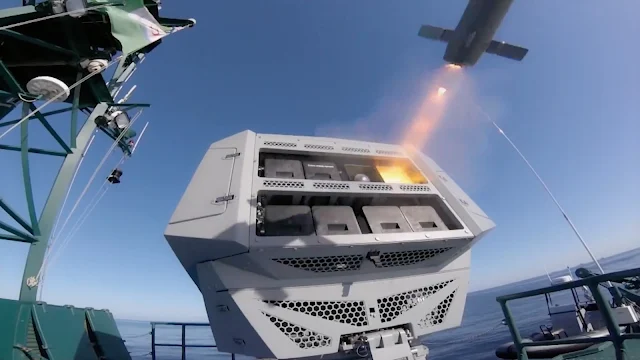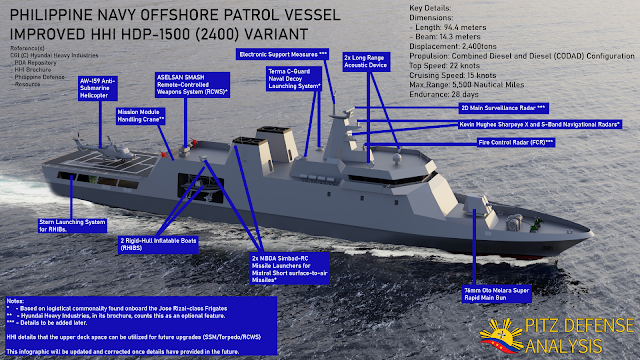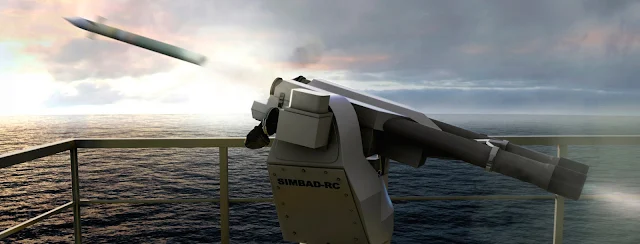The Philippine Navy recently received its two Fast Attack Interdiction Crafts-Missile vessels from Israel, whereby these vessels have produced by Israel Shipyards, adding more brand new naval vessels in the fleet service alongside capable vessels like the Jose Rizal-class Frigates, or the ones in the pipeline like the Corvette and Offshore Patrol Vessel Acquisition Projects.
With this, the fleet is now aspiring to have more vessel of such type, even to where it correlates to the country's stance in its Self-Reliance Defense Posture initiative, as the rest of such vessels may get produced in the country, through the Navy's shipyard.
IN THE NEWS - PHILIPPINE NAVY COMMISSIONED TWO SHALDAG VESSELS
 |
| Philippine Navy has just christened and commissioned two Shaldag-derived vessels known as the Acero-class FAIC-Ms, both produced by Israel Shipyards. (c) Philippine Navy, via Naval News. |
The Philippine Navy recently commissioned two of its newest vessels in the fleet, naming the BRP Nestor Acero (PG901) and the BRP Lolinato To-ong (PG902), two out of nine Shaldag V Fast Attack Interdiction Craft-Missile vessels that the fleet, through the Department of National Defense, has ordered from Israel Shipyards, the manufacturer for these vessels.
In a typical Philippine Navy mandate, these vessels may get deployed in areas such as the West Philippine Sea, supporting the Navy's larger vessels in the area, or in the country's southern waters whereby the borders are porous and these fast attack interdiction crafts can augment law enforcement vessels deployed in the area such as those operated by the Philippine Coast Guard.
These two newly gained Shaldag vessels, known in the Philippine Navy as the Acero-class Fast Attack Interdiction Craft-Missile vessels, are part of the Revised AFP Modernization Program or R.A. 10349, in which the allotted budget for the contract comes at around Php 10 Billion, slated for the country's naval force as part of the Modernization Program's Horizon 2 phase.
This acquisition project comes with the provision of having the first six vessels (including BRP Nestor Acero (PG901) and BRP Lolinato To-ong (PG902)) made in Israel Shipyards's shipbuilding facilities in a port near the City of Haifa, Israel, while the remaining three may get produced in a Philippine Navy shipyard in Cavite as part of the Armed Forces of the Philippines' Self-Reliance Defense Posture initiative or SRDP.
With this, the Philippine Navy is now planning to buy at least 15 more Shaldag-designed Acero-class Fast Attack Interdiction Crafts to the fleet, in which it has a positive effect not only to the market access of Israel Shipyards to the Philippine defense market, but also to the prospect of the Philippine Armed Forces in its approach of upholding its self-reliance defense initiative as we get it discussed throughout this article.
SHALDAG-CLASS FAST ATTACK INTERDICTION CRAFTS RECAP
 |
| Israel Navy's Shaldag Mk. V Fast Attack Craft. Image obtained from Israel Shipyards website. |
Years ago, we made an article wherein we have provided an insight regarding the shipbuilder and the development of these vessels, along with the number of varying Shaldag designs and the Philippine Navy's Fast Attack Interdiction Craft-Missile Acquisition Project itself that has made this endeavor possible to the point of adding more platform of this type under Self-Reliance Defense Posture.
Regarding the vessel manufacturer, Israel Shipyards is basically one of Israel's many state-owned defense industrial complexes, whereby this one focuses primarily on producing indigenously built vessels for the Israel Navy, in which that includes the Shaldag Mk. V in the images whereby it is also the same type of vessel that the Philippine Navy received under its said Acquisition Project that calls for nine units.
Before the Shaldag Mk. V Fast Attack Interdiction Craft has developed and mass produced by Israel Shipyards, there are at least two more known variants that define the Shaldag family of vessels, of which these are the Shaldag Mk. II Fast Attack Boats and the Shaldag Mk. III/IV Fast Attack Boats, whereby the former has opted by the Israel Navy way back January 2002, whilst the latter is basically what it is, an improved variant of the Shaldag Mk. II with tweaks designed in compliance to the requirements needed by the Israel Navy.
The Fast Attack Interdiction Craft-Missile Acquisition Project has seen as one of those essential programs that may help modernize the Philippine Navy, coming alongside other acquisition projects like the Corvette Acquisition Project and the Offshore Patrol Vessel Acquisition Project, all of which are bagged by the South Korean shipbuilding firm Hyundai Heavy Industries.
Now that we have recalled the details of the previously made article, we may now focus deeply on the information surrounding the Philippine Navy's plan to add more Fast Attack Interdiction Crafts into its fleet, whereby the Israel Shipyards having a better chance of having a deal under this proposal as they already delivered the first two Acero-class (Shaldag) vessels to the Philippine Navy fleet, setting up standards for commonality and ease of securing spare parts and operational/maintenance procedures.
ADDITIONAL 15 MORE UNITS
Adding fifteen (15) more Acero-class Fast Attack Interdiction Craft-Missile vessels or FAIC-Ms came as the new Philippine Navy Flag Officer-In Command Rear Adm. Toribio Adaci Jr told the reporters during the commissioning rites of both the BRP Nestor Acero (PG-901, image seen above), and its sister-ship BRP Lolinato To-Ong (PG-902) last November 28, 2022.
This information came as the new Philippine Navy chief stresses the need for additional Fast Attack Interdiction Craft-Missile vessels to meet the Navy's requirements in patrolling the littoral waters, which is clear that this is fully different from the nine units that this naval branch of the Armed Forces of the Philippines ordered, of which two aforementioned vessels has already getting delivered and commissioned into service.
It has taken note that the Philippine Navy, in the last three years prior to the delivery of these Shaldag-derived vessels, has decommissioned its old vessels, most of which has served the Second World War before getting turned over to the Philippine fleet for its operations for the rest of its serviceable life prior to its exit from service with no immediate replacements, like with the decommission of BRP Miguel Malvar (PS19) and BRP Magat Salamat (PS20) last 2021.
Like the old World War 2-era vessels that these Acero-class FAIC-Ms replaced, these vessels are likely to get assigned in the Philippine Navy's Littoral Combat Force, which differs from the large combat vessels of the fleet like the Jose Rizal-class Frigates serving the Offshore Combat Force as the said vessels have different mission requirements and the operational requirements that came with it.
Once this proposal pushes through, this may offset some of the recently decommissioned vessels to where the overall numbers of vessels within the Philippine Navy may replenish that other essential vessels may get assigned to other important areas of assignment, like the key combatants of the Philippine Navy getting assigned to an area of water like the West Philippine Sea whilst the Acero-class FAIC-Ms dealing with littoral areas like the porous Sulu Sea area or in areas off the coast of Southern Mindanao.
MUNITIONS
 |
| An Israel-made Spike missile launch from a Typhoon MLS-NLOS missile system installed on the Azerbaijani Coast Guard's Saar 62 offshore patrol vessel. Image: Azerbaijan State Border Service/YouTube, via The Defense Post. |
While being small vessels, these Acero-class Fast Attack Interdiction Crafts - Missile came with a firepower punch, specifically coming with a naval variant of the SPIKE NLOS (Non Line Of Sight) Missile weapons fit, an Israeli-developed guided munitions courtesy of RAFAEL Systems Ltd., the Israeli defense firm that has also provided the SPYDER Ground-Based Air Defense Systems to the Philippine Air Force.
Like the SPIKE NLOS Naval Variant Missile System, RAFAEL Systems also fitted its Typhoon Stabilized Remote-Controlled Weapons System, or RCWS, with the Typhoon RCWS 30-millimeter cannon variant as its main weapon and two (2) lightweight mini-Typhoons being its secondary weaponry, giving sophisticated and highly precision-based firepower that can sufficiently deter littoral threats.
As for the logistical chains surrounding these weapons systems, it may not go as much of a concern in relation to the use of these weapons fitted onboard the Acero-class Fast Attack Interdiction Crafts-Missile vessels as the SPIKE Missile system are also currently in-use by other naval assets of the Philippine Navy, such as the Multipurpose Attack Craft or MPAC Mk. 3 (in which it uses the SPIKE-ER variant) and the AW-159 Antisubmarine Helicopters that comes with SPIKE-NLOS as one of its primary munitions.
As for the Typhoon Remote-Controlled Weapons System (RCWS), it served as the primary weapons platform for the Acero-class Fast Attack Interdiction Craft-Missile, with the Typhoon Mk. 30-C variant seems to be apparent that it may get on its way onboard the South Korean-made HDC-3100 Corvettes based on our colleagues in the defense community, albeit it is not a full 100% confirmation yet.
These Israeli-made weaponry found onboard these Acero-class Fast Attack Interdiction Crafts-Missile gives assurance to the weapons ecosystem that Israel offers, making it a preferable logistical option for the Philippine Navy in securing spare parts and munitions made by an Israeli Defense company like RAFAEL Systems, such as for its Remote Controlled Weapons Systems and missile system solutions.
TO SUM IT UP
%20in%20Wesmincom,%20ZC%20-%20PDA.jpg) |
| BRP Nestor Acero (PG-901) deployed into the Western Mindanao area, specifically in the regional headquarters in Zamboanga City. (c) Western Mindanao Command |
The Acero-class Fast Attack Interdiction Craft-Missile Vessels purchased by the Philippine Navy are just one of many modernization projects pursued by the Naval Branch of the Armed Forces of the Philippines in desiring to get more capable and newer vessels in its fleet, in its desire to replace the older World War 2 vessels it once have before it went decommissioned from service.
Augmenting other vessels that the Philippine Navy purchased, like the Offshore Patrol Vessels and additional Pohang-class (BRP Conrado Yap PS-39) class Corvettes, the Acero-class Fast Attack Interdiction Craft-Missile vessels may go on as one of the primary platforms intended for littoral security and defense, going along other littoral vessels like the Navy's Multipurpose Attack Crafts or MPACs of differing variant it has in service.
Other than the numerical deployment benefits that the acquisition of the Acero-class Fast Attack Interdiction Craft-Missile vessels brought to the Philippine Navy's overall capabilities, the deal that they have with Israel Shipyards through the Department of National Defense presented an opportunity for getting additional vessels of this type produced in the country, helping the Armed Forces of the Philippines improve its prospects in relation to its SRDP or Self Reliance Defense Posture initiative.
If these plans of adding more Shaldag/Acero-class Fast Attack Interdiction Craft vessels push through, it will both help the Philippine Navy and the country's push for Self Reliance Defense Posture, as this can generate more jobs for the local citizens to get and sustain to feed their families, improving the vibrancy of the country's economy and eventually the experience gathered helps bolster local naval shipbuilding to new heights.
Simply put, the advantages presented in adding these vessels to the Philippine Navy give a promising insight in relation to its boost in capabilities along with the perks that came with it that helps improve the economy, although it is still at the discretion of the decision makers whether that the project is worthy to push through, and the budgetary requirements is available and workable enough for it to materialize smoothly, all for making this aspiration a reality.



%20in%20Wesmincom,%20ZC%20-%20PDA.jpg)





















%20-%20PDA.jpg)





%20-%20PDA.jpg)
.png)



